Murdannia loriformis Bright Star Plant is a charming small vine native to the tropical and sub tropical areas of Asia, Philippines, Sri Lanka, India, and New Guinea. The Bright Star plant grows happily as a houseplant with some basic care guidelines.
Common Names for Murdannia Loriformis include Murdannia, Bright Star Murdannia, Bright Star Plant, Angel Grass plant and the Several Flower Dew flower. But most often you will see it as Murdannia or the bright star.
The Bright Star Murdannia produces leathery ruffled striped foliage. It’s fleshy stems send out trailing arms of beautiful ribbon shaped striped leaves. The Mudannia grows tiny flowers clusters on long stalks that resemble points of starlight.
Murdannia Loriformis is a relative of spider worts (Tradescantia) vines and day lilies in the Commelinaceae plant family. If you know spider worts and tradescantia you will know this plant is related to them by its leaf texture and growth habits.
The leaves are very similar to a tradescantia, including the ribboning color pattern. The lateral growth of the new fleshy stems definitely remind one of a spider wort.
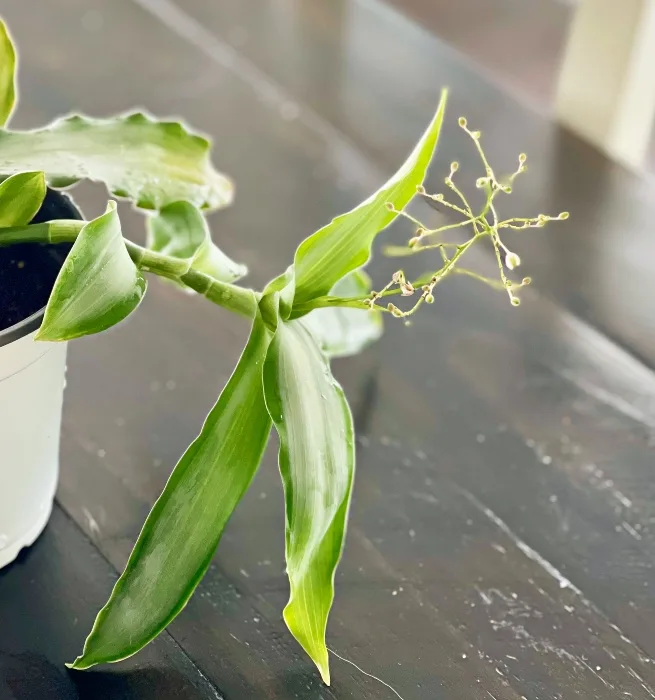
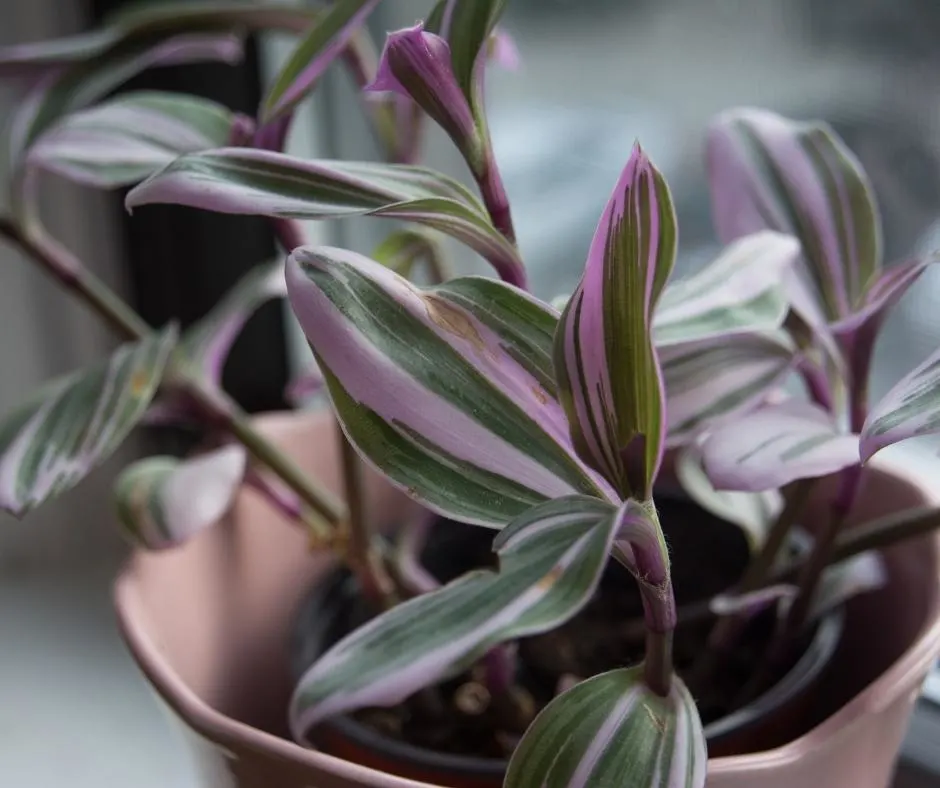
This vine is NOT known to be especially good at filtering out toxins from your household air. But all plants respire oxygen to some degree and use up carbon monoxide. And the Star Murdannia has other benefits to recommend it as a houseplant.
Murdannia Loriformis Benefits:
Murdannia Bright Star Plant benefits. This is an Easy care, non toxic, durable and pretty plant. Murdannia deserves its spot on your plant shelf.
The Bright Star Plant is Non Toxic to pets and humans. You can place it anywhere it will grow with no worries of harm to pets and people.
Plants are very beneficial to people emotionally and as an environmental addition to your home.
Read more about why houseplants are beneficial to people here .
The Contented Plant
As a part of traditional Medicine, Murdannia Bright Star Plant benefits has a wide range of uses.
Murrdania loriformis has been used by traditional Asian herbalists for centuries. This plant has therapeutic agents and a long respected history in traditional medicine within Asian horticulture.
Herbal extractions from M. Loriformis have proven effective in early cancer treatments. Herbalists also use this plant in concoctions to treat colds, throat infections, pneumonia, detoxification and other disease treatments.
In the Proper tincture, extracts of this plant have anti inflammatory, analgesic, and antipyretic properties. For more on the traditional Medicine benefits of the Murdannia Loriformis, read this Pub Med paper.
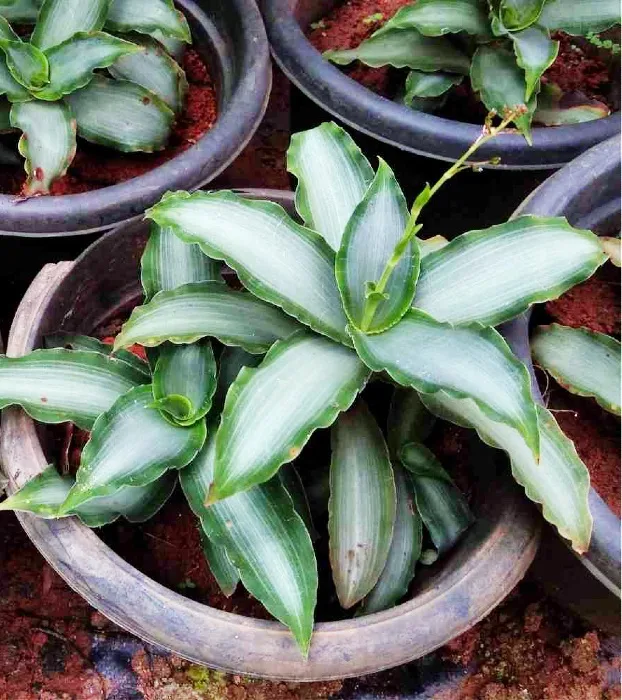
How Do You Take Care Of A Bright Star Plant?
Kayti shares her own experience with the care and propagation of Bright Star plant. She goes over all the care tips and information you will need to grow a happy ‘Bright Star’.
Murdanna Loriformis Quick Care Table:
| Familiar Names: | bright star plant, angel grass plant, Murdannia, several flower dew flower, |
| Scientific Name: | Murdannia Loriformis |
| Plant Family: | Commelinaceae |
| Care Difficulty: | easy |
| Temperature: | 55 degrees F. to 85 degrees F. |
| Watering: | Water when soil is dry down 2/3 of the way into the pot. |
| Soil: | A light soil mix is preferred by Murdannia. The roots need good drainage and oxygen. 60% potting mix to 30% perlite. |
| Fertilizing: | During the growing season fertilize monthly. Or do half doses of fertilizer bi-monthly. |
| Lighting: | Bright indirect light is best. Avoid really low light and extreme harsh hot sun. |
| Growth: | Bushy trailing plant with thick fleshy leaves. This plant trails from long chinch stems and leaves. |
| Blooming: | Except blooms annually during the growing season |
Signs of Stress for the Murdannia Bright Star:
Like tradescantia and day lilies, the bright star is a durable plant. However, if its needs are ignored or neglected it will show signs of stress.
What is Plant Stress? Plant Stress happens when your plant grows in less than ideal conditions. Murdannia will not die when put under moderate stress (at least not immediately). However, you will notice problems with the plant that are silent alarms. We call this plant stress. Your plant will be happiest and likely to grow well when you determine the problem and correct the issue.
Signs of Plant Stress-Ocassionally plants show signs of stress when seasons and conditions change without adjustment. Here are some common ‘tells’ for plant stress and what they indicate.
- Brown tips on leaves-indicates low humidity
- Brown edges on leaves-indicates underwatering
- Burn patches on leaves (brown spots)- indicates fertilizer burn or sunburn
- Leaves reverting to solid green without striping- indicates too low light
- Plant refuses to bloom-indicates poor plant condition
- Yellowing leaves. indicates overwatering- Find out about 7 Reason for yellowing leaves on plants in this post.
- Damage to plant leaves- indicates certain plant pests.
- Faded leaf color- bleaching from too harsh sun
- Drooping leaves- indicates root rot
If you see these stress signals, act to remedy the problem. Bright star plants usually respond well when you eliminate the problem. Read on to learn more about what this plant requires for best health.
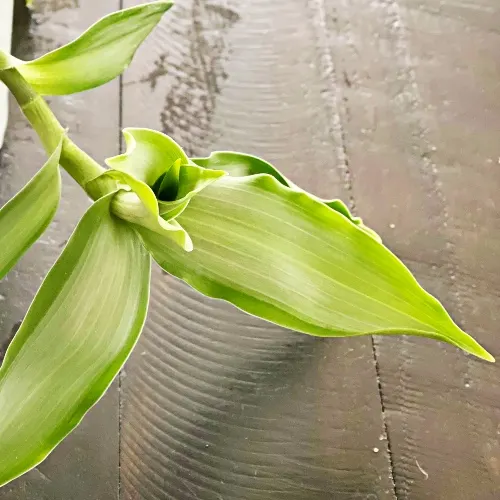
Plant Care Questions for the Bright Star Plant:
How much Light does Bright Star Need?
Bright Star Plant is fairly durable and will survive low light conditions. But with prolonged low light it will suffer. Murdannia Loriformis requires bright indirect light for best growth and color.
Here’s why Proper lighting is important for this vine.
- When Murdannia is placed in good light the variegated pattern stripes will be bright and clear with a silvery grey field on the leaves.
- In low lighting Bright Star leaves produce more chlorophyll. The leaf loses the grey field and stripe as more green is needed. Eventually the leaf will all be green so it can feed itself through photosynthesis. This is called reverting. It means you will have a green plant with little to no ribboning along the leaf edges.
- In Low light, the plant growth slows considerably.
- In low light, murdannia loriformis will not reliably send up flower stalks and bloom.
- Alternately, harsh, hot, direct sunlight will burn the plant and cause brown spots on the leaves.
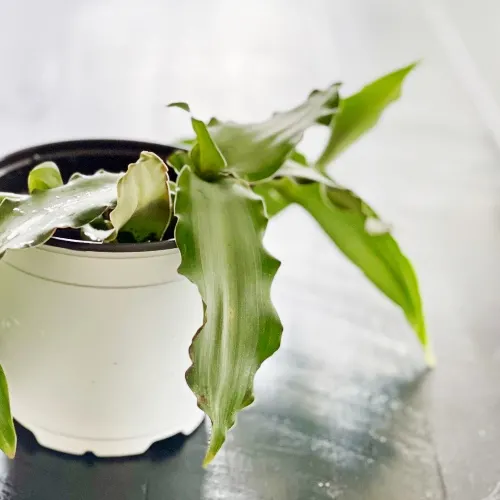
How Do I Water the Bright Star?
Water when the pot soil is dry down to the root zone. Overwatering signs of stress are yellowing leaves and drooping leaves. Constant overwatering leads to root rot and eventually death in Bright Star Plants. It likes some moisture but will suffer if the roots cannot breath.
Watering Tips For the Bright Star Plant:
- Allow the top one third of the soil to dry out before watering. This plant does not like to grow in constantly wet soil.
- Water Loriformis with ROOM TEMPERATURE water. The Bright star is susceptible to temperature shock.
- Use a planter with a good drain hole so water flows out of the pot after watering.
- Bright Star plants will get root rot if overwatered often. Learn how to fix root rot in this post.
- Light soil mixes allow oxygen around the roots and won’t pack down with repeated waterings.
- The watering schedule will change according to the seasons(and humidity and warmth) in your home. Check the soil twice a week and be sure the soil is almost dry before adding water to the pot.
- Watering from the top can attract Fungus Gnats. One way to keep the soil at the surface dry and the plant watered is to bottom water. Learn how to bottom water in this post.
If you water your plant more than it needs you may see drops of water on the leaves. This is the plant respiring and getting rid of water it does not need and can’t use. Water less next time. 🙂
How to add Humidity to the Bright Star.
Bright Star will grow well in 40% up to 70% humidity. Most homes have this humidity range during the growing season. In dry climates, or In winter when heating systems blow warm dry air through the home you may notice brown tips on the leaves. This is a sign of low humidity.
How to Increase Humidity to Murdannia Loriformis:
- WARNING: Do not mist the leaves of Angel Grass. Water tends to sit on the leaves too long and create an opportunity for viruses and molds like powdery mildew. Learn how to treat powdery mildew in this post.
- Set Angel Grass plant on a tray of pebbles. Now pour in water until the pebbles are almost submerged. You do not want the plants pot to suck up the water in the tray. So set a drain plate under the pot. The pebble tray will evaporate water up into the plant leaves. This adds humidity to the air surrounding the plant.
- To add more humidity Group the Bright Star with other plants. As the plant pots evaporate water and the plants respire close to each other, humidity will increase.
- Set a humidifier near the Murdania to provide a consistent level of humidity around the plant.
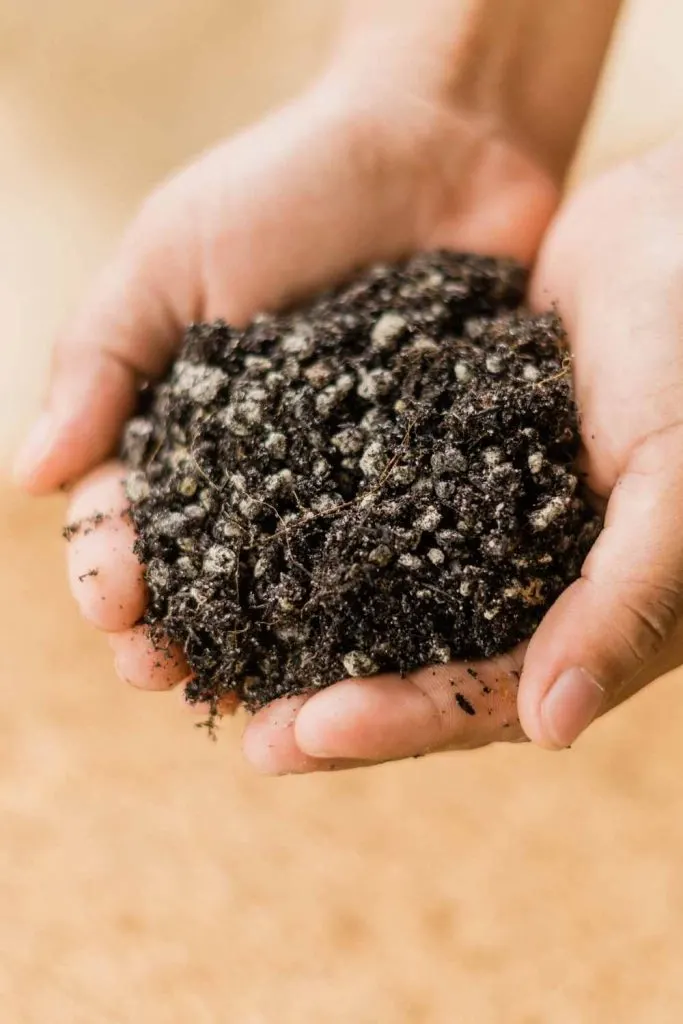
Best Soil Mix for Bright Star Plant:
Murdannia Bright Star requires a light friable soil mix. 60% potting soil with 30% perlite is our preferred soil mix for this plant.
Pests On Bright Star:
Murdannia Loriformis is susceptible to pests. Mealy bugs love the Bright Star as do Spider mites. Learn how to identify and combat the 7 most common indoor plant pests in this post.
For best practice, when you water Bright Star lift the leaves and check the undersides and plant crevices for unwelcome webs and critters and plant damage. Treat the plant immediately with our suggested treatments.
Another deterrent to pests is leaf washing. Once a month or so wash the leaves of the Bright Star with either plain water or a neem oil mix as directed on the package. Neem oil is both a pest deterrent and a leaf wash. The plant leaves will shine with a neem oil wash and all the colors will look great. Leaf washing also opens all the leaf pores (stomatas) so the plant can respire well, photosynthesize and look beautiful.
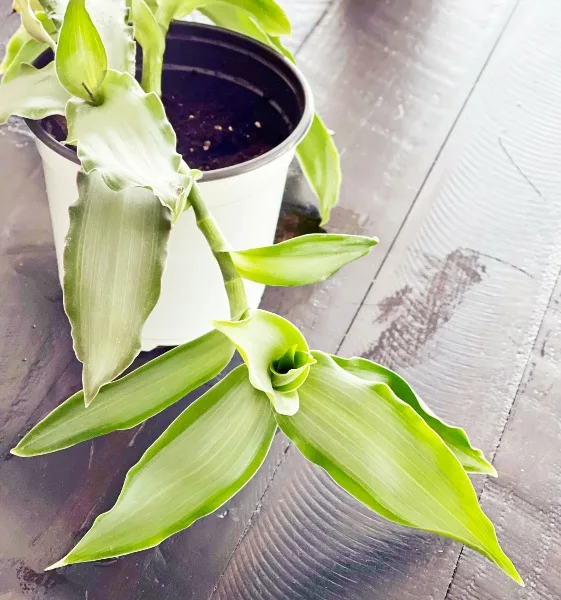
How To Propagate Murdannia Loriformis:
Murdannia Loriformis is easily propagated by stem cutting: Cut the stem in the internodal zone (between the leaf node bulges) and place the cutting in either a jar of water with the leaves OUTSIDE the water, or place the cutting in moist soil and keep the soil moist until the plant stem grows roots.
It takes several weeks to see new roots or signs of growth. The cutting may look a bit droopy and lose a leaf or two before the plant begins to feed its self with new roots.
Remember, Bright Star plant is easily shocked with temperature changes. For best results let your water sit out a day to allow chemicals to evaporate and the water to come to room temperature.
If the stem cutting bottom gets mushy in water this is a sign of trouble. Bacteria may have set into the water. The Easiest way to avoid cloudy water and a mushy stem is to change out the water every few days.
Flowers on Bright Star Plant:
The Bright Star Plant will send up stalks during the growing season with clusters of tiny flowers that resemble starlight.
If your murdannia is healthy, well tended and fed, the plant is a reliable bloomer. If you prefer the leafy growth and want to cut off the flower stalks the plant will not be harmed.
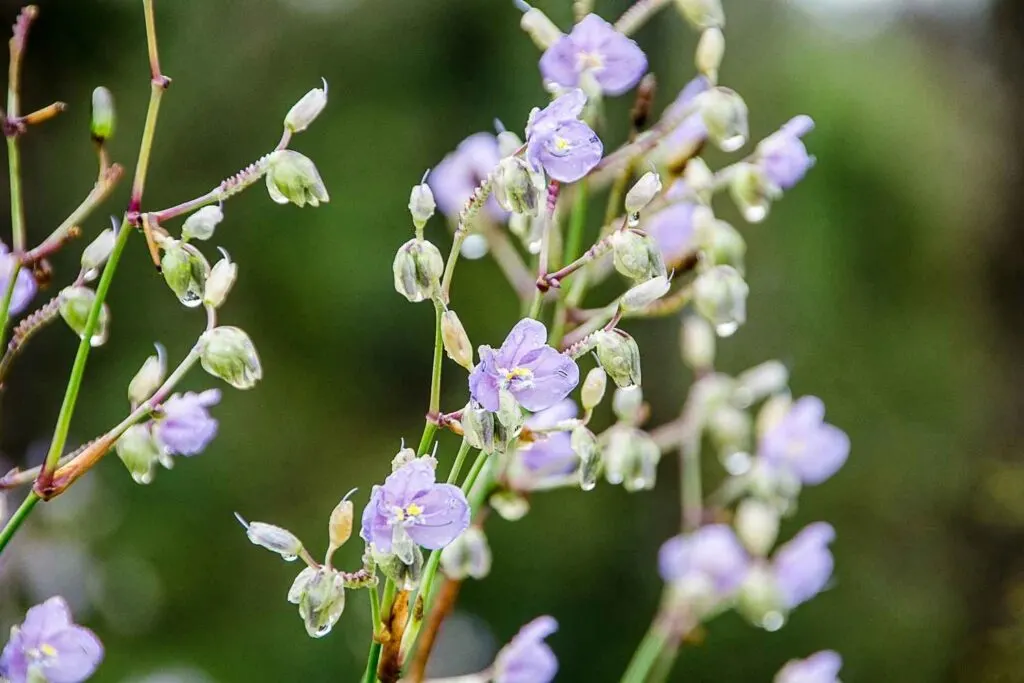
A happy Murdannia Loriformis will send up stalks with tiny flower clusters that bloom into pinpoints of color like starlight.
Related Content:
Follow Us:
Find us on YouTube, Instagram , Pinterest and TikTok! We love to Plant chat. We also comment, like and occasionally share your content to our daily stories. We’d love to see your plants. Share your joy in your houseplants. Happy Planting!
Latest Posts:
- 5 Fantastic Cactus Species for Your Home
- Pygmy Date Palm Trees
- Bromeliad Care Guide and Profile
- Growing Gloxinia Plants in Your Home
- Staghorn Ferns Care and Maintenance
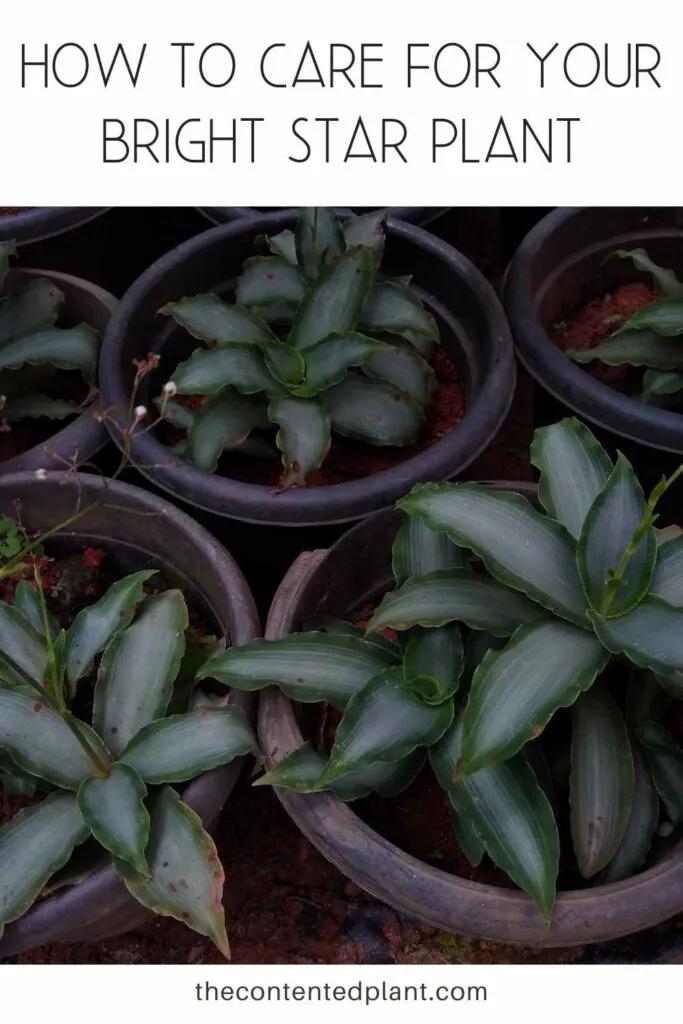

Louise
Saturday 3rd of February 2024
Thank you for this. I've just bought one as discounted and there is little to no information